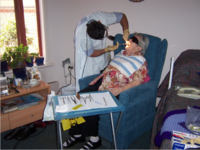
Photo from wikipedia
Objective: The purpose of this study was to investigate the importance of environments (dry and wet) to dislodge the clasp. Materials and Methods: Mandibular test models with natural premolar and… Click to show full abstract
Objective: The purpose of this study was to investigate the importance of environments (dry and wet) to dislodge the clasp. Materials and Methods: Mandibular test models with natural premolar and molar teeth were used to test four types of clasp (each 12) (Akers, rest plate Akers [RPA], half and half [H-H], and ring clasp) in dry and natural fresh saliva environments. Each clasp was pulled out 10 times with a crosshead speed of 10 mm/min and the force required to withdraw each was measured. Statistical Analysis Used: A paired sample t-test and Wilcoxon test were used. Results: There were significant differences between the dry and wet (natural fresh saliva) environment. However, while the mean of the environment for RPA and ring clasp type was significantly different, the H-H and Akers clasp type was not. Conclusion: The environment has an effect on dislodging the clasp but differs according to the type of clasp.
Journal Title: European Journal of Dentistry
Year Published: 2017
Link to full text (if available)
Share on Social Media: Sign Up to like & get
recommendations!